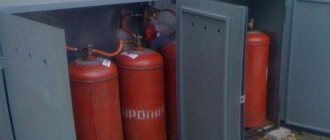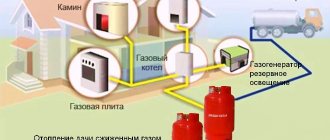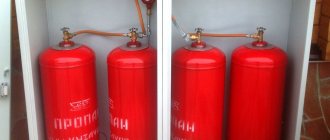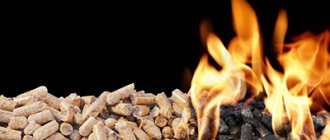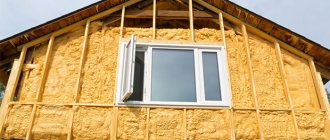How much does it cost to heat with wood?
On average, for heating a house with wood, the cost is calculated according to the following value: the price of 1 kW/hour is 0.7 rubles, which is about 3 times cheaper than when using electricity. On average, 1 heating season costs about 70,000 rubles, that is, approximately 10,000 rubles per month. The calculations are approximate, but from them you can first determine whether this heating method is beneficial for the household.
Fuel is usually purchased in advance, and it is more profitable to immediately purchase a large batch, designed to last for several years. In rural areas, purchasing firewood is usually not difficult; in some areas it is still possible to prepare it yourself.
When making calculations, you need to take into account the possibility of a colder winter than usual: the weather in Russia is completely unpredictable, and depending on meteorological factors, the consumption of firewood varies significantly. This is another reason to buy firewood in advance: if there is fuel left, you can buy less for next year, and if the winter is very cold, there will be no problems with fuel shortages.
With all the pros and cons, heating with wood remains a very profitable solution for many areas. It is difficult to find a more affordable and reliable fuel that will protect your home from even the most severe cold weather and not depend on any centralized networks. Wood heating is now gaining popularity in Europe, as humanity is trying to return to renewable energy sources using more modern energy-saving equipment.
Egor Kondratyuk
Author of publications on 1Drevo.ru with the topics: Houses made of rounded logs | House made of rounded timber | Gas boiler for home | Rounded garage | Choosing an electric boiler | Polycarbonate canopy | Clapboard finishing | Base finishing | Log house for shrinkage | External insulation | Cedar house | Profiled timber | Wooden fence | Finnish house made of timber | Roof installation | Shallow foundation, etc.
Was this publication useful to you?
Bookmark it on social networks!
Total score: 4Votes: 81
Modern wood stoves for heating a home: which one to choose
Stoves for water heating in a private house
We recommend! — Encyclopedia Wooden Houses — NEW
You can find out detailed and expanded information on the topic of the article from the book “Wooden Houses,” which reflects all stages of building a house, from laying the foundation to installing the roof. Book price = 77 rubles.
You may also be interested in other BOOKS on building houses from wood with your own hands.
We recommend other posts on this topic:
Hydrogen generators for heating residential buildings
Electric heating element for a home heating system
Electric heating in the country on weekends: efficiency and costs
Installation of a boiler and installation of electric heating in a private house
Russian stove with a water circuit for heating a house
How to install central water supply in a private house
Basic ways to save heat
Economical heating of a private house with wood has become possible thanks to the use of modern stoves: fireplaces with closed fireboxes have doubled the efficiency, and it reaches 75%, just like good gas stoves. Even if you decide to install a regular Russian stove, its efficiency can also vary significantly.
This depends on the materials, the correctness of the masonry, and the performance of the chimney. A wood heating stove with an efficiency of 90% remains an unattainable dream for many: so far only high-tech gas equipment can boast such efficiency.
When heating a house with wood, consumption can be reduced using simple “rustic” methods that have been used for decades. A few basic measures will make it possible to significantly reduce heating costs:
- The optimal amount of heat is provided only by dry firewood, the combustion of which produces clear smoke with a pleasant woody smell. When burning wet wood, white steam appears - the evaporation of water leads to wasted heat loss and ineffective combustion of fuel.
- The efficiency of the stove is significantly reduced if the chimney is clogged with ash and soot. At the same time, traction deteriorates, and due to an insufficient supply of oxygen, the fuel does not burn completely, giving off a minimum of heat.
- There is another method, which, according to home owners, makes it possible to reduce fuel consumption by half. It involves taking combustion air not from the room, but from the street: the increased flow of oxygen allows the wood to burn out entirely, while it will not take heat from the house.
- The most important condition for saving fuel is proper insulation of the house. It is necessary to insulate not only the walls, but also the floor, foundation, and roof.
It is not difficult to distinguish dry wood: if you hit one log on another, the sound should be clear. It is important to ensure that firewood is stored correctly so that it will always be ready for use.
In addition, toxic carbon monoxide can be released, which can negatively affect human health. Regular cleaning of furnaces can completely solve the problem: removing soot from the walls increases the performance of the entire system.
Thus, modern gas boilers are initially designed to take air from the street. When modifying the design, the stove can take air from the basement of the house.
Most of the heat simply leaves the house through unsealed cracks in the walls or cold bridges in the under-roof space. For your home, you can use modern insulation in combination with waterproofing and vapor barrier membranes.
An economical wood-burning stove for heating a house involves the use of a water or air circuit for heating. In this case, the heat will be evenly distributed throughout the rooms, and for this it is not necessary to use a large amount of fuel.
Such heating is possible by installing an additional heat exchanger in the furnace structure: the most common solution is the so-called “water jacket”. The water is heated by the combustion of fuel and enters the piping system to the radiators, after which it returns to the furnace.
This heating system eliminates the main drawback of a traditional wood stove: uneven heating of the air in the rooms. If it is always very warm near the stove, then in distant rooms the air will always be much colder. If you install radiators and turn an ordinary stove into a solid fuel boiler, this will allow you to warm up every room.
Important characteristics of logs, depending on the type of wood
When asking the question “which firewood is best for a solid fuel boiler,” you need to know its most significant characteristics. In particular:
- calorific value;
- ash content
A long-burning solid fuel heating boiler that uses wood with high ash content will have to be cleaned frequently. Without taking this into account, the grates of the boiler unit will quickly become clogged with ash, which will lead to a decrease in the efficiency of the boiler. Of course, if the basis for private heating is a long-burning solid fuel boiler on wood with a fully automated mode, then there is nothing to worry about. Otherwise, you need to change the type of wood.
Another important characteristic of firewood is its calorific value. Using wood logs with a high calorie content, a long-burning solid fuel heating boiler will withstand the required heat load for a long time, creating the desired temperature regime in the interior space of a country cottage. This characteristic largely depends on the density of the wood itself.
As a result of experimental tests, the following results were obtained for the most common types of firewood (list in descending order):
- oak – 3106 kcal;
- birch – 2805 kcal;
- pine – 2128 kcal;
- from alder – 2095 kcal;
- spruce – 1847 kcal;
- aspen - 1764 kcal.
Despite the fact that oak firewood is the most efficient in producing heat, its cost is significantly higher than all other types of firewood. Thus, it is more profitable to heat a solid fuel heating boiler, based on the cost of wood fuel, with birch firewood.
What you need to know to calculate
How much firewood is needed to heat a house depends on several factors:
- the amount of thermal power spent on heating;
- equipment in use;
- types of wood;
- wood humidity.
According to the standards, the thermal power is 1 kW of heat per 10 sq. m in extreme cold. The average value is 0.5 kW. Thus, for a building of 100 sq. m it will be 5 kW.
The more spacious the housing, the higher the fuel consumption. The efficiency of different types of heating devices differs. For most solid fuel boilers this parameter reaches 70–75%. Pyrolysis models are more efficient - their efficiency reaches 80%. Russian and steel stoves have the lowest heat output. Their efficiency on average is 65%, 55%, respectively.
Deciduous and coniferous trees are used for heating. Birch has the highest heat transfer – 2371 kW/cu.m. m at 50% moisture content and 2716 kW/cu.m. m at 20% water content. The minimum calorific value of a Christmas tree is 1667 kW/m3 at a humidity of 50% and 1902 kW/m3 at a moisture content of 20%.
| Wood type | Calorific value of freshly cut wood at 50% humidity, kW/m3 | Calorific value of semi-dry wood 30% humidity | Calorific value of dry wood 20% humidity, kW/m3 |
| Pine | 1900 | 2071 | 2166 |
| Birch | 2371 | 2579 | 2716 |
| Spruce | 1667 | 1817 | 1902 |
| Aspen | 1835 | 1995 | 2117 |
| Alder | 1972 | 2148 | 2244 |
| Ash | 2550 | 2774 | 2907 |
Table 1. The calorific value of firewood of different types, related to the measure of volume - 1 m³.
When preparing for wintering, you need to know how to calculate cubes of firewood. For this purpose, special formulas have been developed to calculate the norm of logs for the autumn-winter season.
Resolution of the Head of the Novopokrovsky rural settlement of the Novopokrovsky district dated 02/04/2009 N 10
Text of the legal act as of August 2012
In accordance with Decree of the Government of the Russian Federation of May 23, 2006 N 306, taking into account the caloric content of fuel, I decide:
1. Approve solid fuel consumption standards per month of the heating period: coal - 8.5 kg/sq.m, firewood - 0.025 cubic meters/sq.m.
2. Entrust control over the implementation of this Resolution to the deputy head of the Novopokrovsky rural settlement for improvement issues N.P. Kovalya.
3. The resolution comes into force on the day of its official publication.
Head of the Novopokrovsky rural settlement M.I. GRECHUSHKIN
Appendix to the Resolution of the head of the Novopokrovsky rural settlement dated February 4, 2009 N 10
SOLID FUEL CONSUMPTION STANDARDS
——+———————-+——————+——————- ¦ N ¦ Indicator ¦ Per month ¦ In heating ¦ ¦ ¦ ¦ heating ¦ period (based on ¦ ¦ ¦ ¦ period ¦ 6 months) ¦ +—-+———————-+——————+——————+ ¦ 1. ¦Coal supply standard ¦ 8.5 kg/sq.m ¦ 51 kg/sq.m ¦ +—-+———————-+——————+——————+ ¦ 2. ¦Firewood supply standard ¦0.025 cubic meters/sq.m ¦ 0.15 cubic meters/sq.m ¦ ——+———————-+——————+——————-
To calculate the standard for thermal energy consumption per 1 square meter of total area, Decree of the Government of the Russian Federation of May 23, 2006 N 306 (formula 2) was used, taking into account the calorific value of the fuel.
Methodological guidelines of the State Unitary Enterprise of the Academy of Public Utilities named after. K.D. Panfilova (2002, edition 4).
Formula for determining the heating standard (formula 2) (coal)
The heating standard (Gcal per 1 sq.m. per month) is determined by the formula:
Qо Qо No = ——- = —— x 2 = 0.0375 Gcal/sq.m (heating period), S x 12 S x 12
Where:
Qо - the total consumption of thermal energy for heating the residential premises of an apartment building or residential building, determined as the sum of the readings of collective metering devices for the heating period (Gcal) (for 12 households it is 91746.6 Gcal);
S - total area of residential premises of an apartment building or premises of a residential building (sq.m) (for 12 households it is 408,282 sq.m).
P = N x S (Gcal/month).
The average caloric equivalent value for converting natural fuel into conventional fuel for coal from the Donetsk basin is 0.94.
P x 213.2 A = ————, kg (per month/sq.m), 0.94
where 213.2 is Donetsk coal (production of 1 Gcal of heat kg of standard fuel);
0.94 is the equivalent of converting natural fuel into conventional fuel and vice versa.
Necessary thermal energy costs for the heating period:
tin — tср Qо = G x ———— x T (Gcal/heating period), tin — tro
where G is the total heat load for heating residential buildings (heating period) (for 12 households it is 54258400);
tin — internal air temperature of heated residential premises (18°C);
tro is the estimated outside air temperature for design purposes (for Novopokrovskaya -22°C);
tsro - average monthly temperature during the heating period (2.57°C);
T - hours during the heating period (4392).
8.5 x 6 = 51 kg/sq.m.
To calculate the rate of firewood consumption for heating residential households, due to the lack of individual standards, fuel consumption rates in kg of equivalent fuel are accepted.
Rules and safety precautions when collecting firewood
When working with an ax, check the reliability of the handle and, if necessary, make repairs. The electric wood splitter is inspected for cable integrity. The machine is freed from foreign objects and, following the following rules, safety precautions are observed:
- Wear overalls, gloves and goggles. Shoes are selected with stable soles.
- The cord is connected to the network. Autonomous equipment is filled with gasoline and lubricating oil.
- The log is placed on the work surface in a horizontal position. The cleaver is passed along the fibers.
- If a hard knot is encountered, set the pusher handle to the “Start” position and repeat the blow.
Warning! The employee must not be in a state of alcohol, drugs or under the influence of potent medications.
What tools and equipment will be needed to prepare firewood?
In Rus', axes and saws were used to fell wood. Tools have changed since then, and powerful electrical equipment has appeared that performs the most difficult work and speeds up the process. To prepare firewood for the winter, prepare the following tools:
- chainsaw;
- electric saw;
- splitting axe;
- wood splitter
Check the oil and sharpness of the chain on the electric saw.
The chainsaw is driven by the engine. Fill the tool with gasoline. A chain saw helps clear a log house from branches and cut logs and logs. Professional and household models differ in power and duration of uninterrupted operation. The mobile tool is suitable for deforestation.
The electric saw has a power cord that plugs into an outlet. The engine is distinguished by power and location: longitudinal or transverse. The first is highly stabilized, which makes work easier. The tool should only be used close to a power source.
The splitting ax is used for chopping logs for firewood. The long handle allows you to make an amplitude swing and increases power. The V-shaped cleaver does not get stuck in the wood, but splits along the grain. Sharpening is performed at an angle of 40-60 degrees
A wood splitter simplifies the process of chopping logs. There are horizontal and vertical feed of round timber. The log slowly moves towards the cleaver and is divided into 2-4 parts.
Bulk instead of real ones.
Let me draw your attention once again to the fact that we are talking about dry firewood with a moisture content of no more than 20%. The calorific value of 1 kg of such firewood will be at least 4 kW. But if their humidity turns out to be increased, which most often happens, then their calorific value drops sharply. For example, 50% humidity will reduce the heating value of firewood by half. So the main disadvantage of wet firewood is not that it does not burn well, but that it produces little heat. And finally, about one more trick that firewood sellers most often resort to. Cubic meters are real, folded and bulk. You pay money for a real cubic meter, but, alas, a rare seller uses real cubic meters when calculating the volume. In the best case, you will get folded cubic meters, in the worst - bulk. So not only trust, but also verify!
How to calculate wood consumption for heating a house
Average statistical data show that the wood consumption for heating a 200 m2 house is usually about 15-20 cubic meters. This is a very approximate value, which is estimated when many factors coincide. An example of calculating the amount of firewood for an ordinary village house is as follows:
Let's calculate the amount of heat required to heat a properly insulated wooden house with an area of 150 square meters. meters. In the cold season, the average daily energy consumption is 50 W/m²; the house will need to be heated for 214 days. We calculate the total amount of heat:
50 W/m² *150 sq. m * 24 hours * 214 days = 38.52 MWh, this value will be equal to 33 Gcal.
A kilogram of absolutely dry firewood emits 4440 kilocalories of heat when burned. If the firewood sits for about a year, its humidity will be 20%, and the amount of heat released during combustion will be equal to 3400 kilocalories.
Using the formula, we calculate the total amount of oak firewood, the density of which is 0.730 kg/m³. The total amount of 33,000 kilocalories must be divided by the amount of heat released during the combustion of wood and the density of the wood. As a result, the total amount will be approximately 19 cubic meters of firewood needed to heat the house throughout the cold season.
If you use other species than oak firewood, the resulting value may change: for birch firewood it will be 21 cubic meters, and for pine – about 26 cubic meters. With economical consumption and careful handling of heat, this value can be significantly reduced.
Void volume
What is the most common way to transport firewood? That's right, on old Russian-made trucks. And we know something about them. The body volume of the “53rd” “lawn” is 4.8 cubic meters. m. There is also a “collective farm” modification with high sides, then the volume increases almost 2 times. The volume of firewood in the body also depends on how it is stacked. But tell me, has anyone ever had neatly stacked firewood delivered to them?
They are almost always in bulk in the back. Well, accordingly, there is also a lot of empty space between the logs. However, there is nothing insurmountable for science in this ugly heap. because there is a special coefficient for converting the bulk volume into the volume of folded cubic meters. And it depends on the length of the log.
For example, for a 1/4 m log, the correction factor is 0.8. And for a log of 3/4 m - already 0.73. What does this wisdom mean for those who are not very good at mathematics? And the fact that 4 cubic meters of firewood with an average length of 25 cm, brought in bulk, after stacking will turn into 3.2 cubic meters.
Best answers
Zhanna K:
my neighbor’s house is 6*6, that is, 36 square meters, made of timber, with an attic, he took 10 cubic meters last year, that is, Kamaz in bulk, barely enough for the winter, that is, 2 Kamaz trucks will probably be enough for you. The stove is also Butakova, it was always warm in the house.
Mikhalych:
it’s easy to calculate from the daily “norm” 80-120 liters per day passport request x for 30 x 8 months = 19 - 29 m3 WAREHOUSE (!) i.e. folded, not cubed from round timber...)))))
Anaida Zagoskina:
A lot depends on the stoves that heat your home. As a rule, such a room cannot be heated with one stove. If you have a baker and a stove, that is, two ovens, then 10 cubes will be enough. Heat the baker in the morning, and heat the stove or floods closer to lunch. The average temperature in the living space will be maintained constantly. If the bakery has a good chimney, then the additional stove can be heated in the evening.
Nikita:
I live in the north, a house of 90 square meters, 150x150 timber, a brick stove with a homemade water boiler, enough for 10 cubic meters (unsawn) for the whole winter + a bathhouse in winter 2 rubles a week, in summer every day. If you can do better with this crap, feel free to scrap it
Sergey Bogatyrev:
house 40 m 17 cubic meters but this is with a margin



